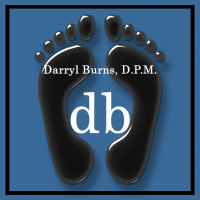Darryl E. Burns, D.P.M.
Diplomate
American Board of Podiatric Surgery
Salinas: 951-E Blanco Circle | Salinas CA 93901 | (831) 422-0442
Post Operative Surgery Instructions
* First 48 hours (2 full days)
- If allowed limited weight-bearing: stay off your feet as much as possible. Only get up to use the restroom or eat.
- If your surgery requires that you are entirely non-weight bearing: You will be fitted with crutches and absolutely must not place any weight on your foot. This means at all times.
- If you have a post-operative walking cast, you may be instructed to walk with the assistance of crutches or a walker until balance is controlled.
- Keep your bandages completely dry and clean. Some bleeding through the bandages is normal and is no cause for alarm.
- A limited amount of discomfort, swelling, and bruising is normal.
- Elevate your foot continuously. It needs to be at a level higher than your heart. Usually, 2-3 pillows will achieve this. Remember, your heart is not up near your shoulder.
- Wear your post-op shoe all the time, including when you are home. Wear it the first night or two as well to avoid hurting your foot when you are asleep. Your foot may still be ‘asleep’ from the local anesthesia well into the night. Never do ANY walking without your post-operative shoe.
- ____If this option is checked, apply an ice bag to the top and inside part of your ankle. Leave it on for 20 minutes, then off for 40 minutes the first 2 days when awake. This will reduce swelling. Again, do not let the bandages get wet. Wet dressings can lead to infection.
- Take prescribed medications as directed. You should start taking pain medication before the local anesthesia wears off so you will have the medication in your system and be more comfortable. Take the pain medication with food to prevent any possible nausea. Also, it is good to take a multi-vitamin daily.
- Eat healthy foods: fruits, vegetables, and lean proteins. Drink plenty of non-caffeinated fluids.
- Smoking inhibits the body’s ability to heal and constricts blood vessels. It is best to quit, but at least stop for 2 weeks.
Call Dr. Burns’ office IMMEDIATELY if:
- Your bandages become saturated (soaked) with blood
- If your pain medication does not stop the discomfort
- If you develop a fever with a temperature of 100 degrees or more
- If you bump or injure your surgery site
- If you are having an adverse reaction to a medication such as a rash, itching, shortness of breath, or severe nausea, vomiting, and diarrhea.
A common occurrence after surgery is the sensation of the bandages being too tight. All you need to do to relieve this is to split the very top dressing with scissors on the top of your foot, taking care to leave the dressing underneath intact. Just nip it about 2 inches and you will get relief.
*After the first 48 hours:
After 48 hours , gradually increase the time you spend on your feet. Walk or stand according to your tolerance levels; when you are feeling discomfort, lie down and elevate your foot. Do not sit with your foot down for any length of time and do not cross your legs. Both activities decrease circulation and increase swelling for the first several days.
Continue to keep the bandages completely dry. There are ‘showering bags’ available commercially. Other people have done creative things with plastic bags; some simple sponge bathe until they are able to bathe or shower normally.
Much of the success of your surgery depends on you.
Please follow these instructions carefully.
If you have any questions or concerns, do not hesitate to contact our office.
There is a 24-hour answering service; if you are calling after office hours we can be reached. The phone may ring several times before the service picks up the call.
Your first post operative appointment:
Date____________________Day____________
Office: Salinas___Time___________

